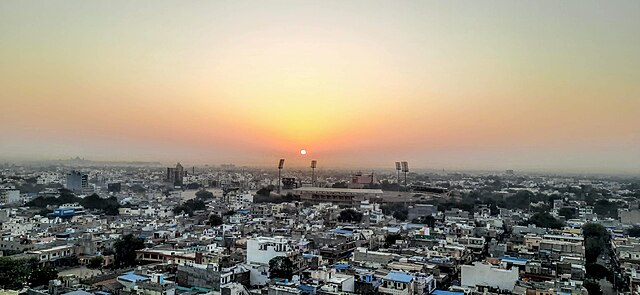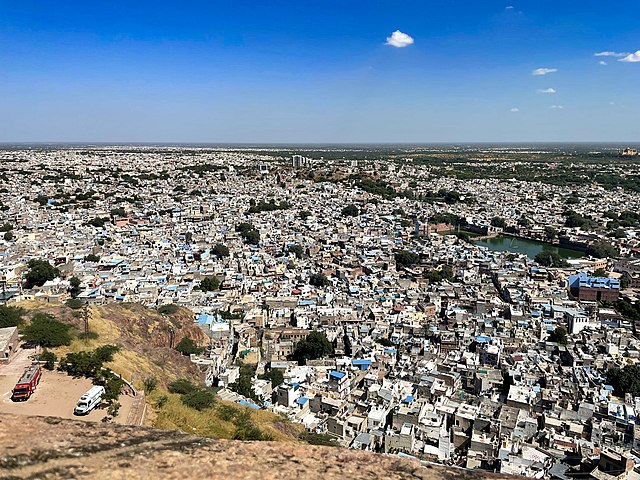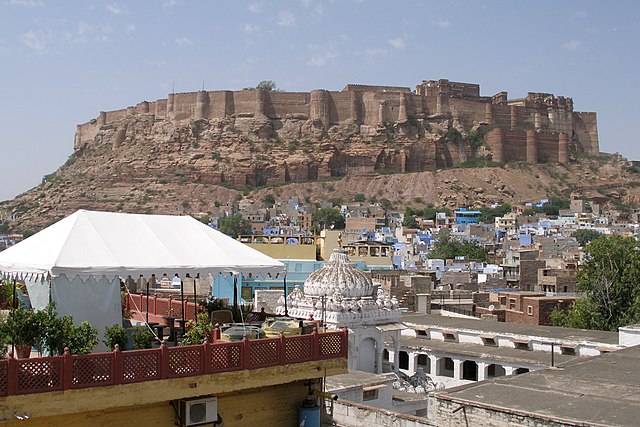Ever wondered what it’s like to step into the heart of Rajasthan, where the sun reigns supreme and the weather tells a story of its own? Jodhpur, fondly called the Sun City, isn’t just about majestic forts and vibrant bazaars—it’s a place where the weather shapes your experience. Whether you’re planning a trip to explore Mehrangarh Fort or just curious about the climate, understanding Jodhpur’s weather is key to making the most of your time here. Let’s dive into the nitty-gritty of Jodhpur’s climate, from sizzling summers to crisp winters, and everything in between.
Why Jodhpur’s Weather Matters
Jodhpur’s weather isn’t just small talk—it’s a big deal. Nestled in the Thar Desert, this city experiences a hot semi-arid climate that can catch you off guard if you’re not prepared. Imagine stepping out to explore the blue-hued streets only to be met with a heatwave that feels like a dragon’s breath. Or picture a chilly winter evening where you’re sipping masala chai under a starry sky. Knowing what to expect helps you pack right, plan activities, and stay comfortable. So, what makes Jodhpur’s weather so unique? Let’s break it down.
A Snapshot of Jodhpur’s Climate
Jodhpur’s climate is like a dramatic play with three main acts: summer, monsoon, and winter. Each season brings its own vibe, from scorching heat to refreshing rains and cool breezes. The city sits at about 244 meters above sea level, which, combined with its desert surroundings, creates a climate that’s both extreme and fascinating. Temperatures can swing from a blistering 45°C in summer to a chilly 10°C in winter. Curious about what each season has in store? Let’s explore.
Summer in Jodhpur: The Heat is On
Summer in Jodhpur, from March to June, is like walking into an oven. Daytime temperatures often soar above 40°C, sometimes hitting 45°C or more. The sun blazes down relentlessly, and the air feels dry as a bone. It’s not uncommon for locals to stay indoors during the peak afternoon hours, sipping cold lassi to beat the heat. If you’re visiting during this time, lightweight cotton clothes, sunglasses, and a trusty water bottle are your best friends. But don’t let the heat scare you—early mornings and evenings offer a chance to explore with slightly cooler temps.
Monsoon Magic: When Jodhpur Gets a Refresh
Come July, the monsoon rolls into Jodhpur like a long-awaited guest. From July to September, the city gets a break from the relentless heat as clouds bring sporadic showers. Rainfall here isn’t as heavy as in coastal India, averaging around 360 mm annually, but it’s enough to transform the arid landscape into patches of green. Expect temperatures to hover between 30°C and 38°C, with humidity creeping up. The rains can make the streets of Jodhpur a bit muddy, so pack waterproof shoes and an umbrella if you’re visiting during this season.
Winter Wonders: Jodhpur’s Cool Escape
Winter, from November to February, is Jodhpur’s golden season. The weather turns pleasantly cool, with daytime temperatures ranging from 20°C to 28°C and nights dipping to 10°C or lower. It’s the perfect time to wander through the city’s forts, palaces, and markets without breaking a sweat. The clear skies and mild temperatures make winter a favorite for tourists. Ever thought about enjoying a sunset at Jaswant Thada with a gentle breeze? Winter’s your season.
What’s the Weather Like Today in Jodhpur?

As of June 18, 2025, Jodhpur’s weather is likely transitioning from the tail end of summer heat to the early monsoon vibes. Based on recent patterns, expect daytime temperatures around 38°C to 42°C, with nights cooling down to about 30°C. The skies might be partly cloudy, with a chance of dust storms or light showers, especially given recent alerts about thunderstorms in the region. Humidity could be around 30-40%, and winds might blow at 15-25 km/h from the southwest. Want to stay updated? Check reliable sources like The Weather Channel or AccuWeather for real-time forecasts.
Air Quality in Jodhpur: What to Know
Jodhpur’s air quality can be a mixed bag, especially in the dry, dusty summer months. The Air Quality Index (AQI) often sits in the moderate range (50-100), but dust storms can push it higher, especially in June. Sensitive groups, like those with respiratory issues, might feel the effects of dust in the air. During monsoons, the air gets cleaner as rain settles the dust, but humidity can make it feel heavier. Planning outdoor activities? Keep an eye on AQI updates from sites like aqi.in to stay safe.
Tips for Dealing with Jodhpur’s Air Quality
Navigating Jodhpur’s air quality is easier with a few tricks up your sleeve. Wear a mask during dusty days, especially if you’re exploring open areas like Mandore Gardens. Stay hydrated to keep your throat from feeling scratchy, and consider indoor attractions like the Umaid Bhawan Palace Museum if the AQI spikes. Got allergies? Pack some antihistamines just in case. The good news? Jodhpur’s air quality is generally better than in bigger cities like Delhi, so you’re not in for a smoggy surprise.
Seasonal Activities: Making the Most of Jodhpur’s Weather
Jodhpur’s weather sets the stage for what you can do. Each season offers unique experiences, so let’s match your plans to the climate. Whether you’re a history buff, a foodie, or an adventure seeker, there’s something for everyone. Ready to plan your itinerary? Here’s how to enjoy Jodhpur, season by season.
Summer Adventures: Beating the Heat
Summer might be hot, but it’s also when Jodhpur is less crowded. Start your day early with a visit to Mehrangarh Fort, where the morning breeze makes exploring bearable. Head to indoor spots like the Toorji Ka Jhalra stepwell or local cafes during the afternoon. Craving something cool? Try a mango kulfi from a street vendor. Evening walks in the Rao Jodha Desert Rock Park are perfect as the temperatures drop. Just don’t forget your sunscreen!
Monsoon Moments: Embracing the Rain
The monsoon brings a refreshing vibe to Jodhpur. The rains make the desert bloom, so it’s a great time for photography at places like Balsamand Lake. The city’s vibrant markets, like Sardar Market, come alive with the scent of wet earth and spices. Monsoon isniest rains can make roads slippery, so stick to main routes or take a rickshaw to stay dry. A rainy day visit to a cozy cafe for some Rajasthani dal bati churma is a must!
Winter Delights: Exploring in Comfort
Winter is Jodhpur’s peak tourist season for a reason. The mild weather is ideal for long walks through the old city’s blue streets or a camel safari in the nearby desert. Attend the Rajasthan International Folk Festival (RIFF) if you’re visiting in February—it’s a cultural extravaganza. Evening bonfires at desert camps are a winter highlight, complete with folk music and starry skies. Pack a light jacket for the chilly nights, and you’re set.
How to Prepare for Jodhpur’s Weather
Packing for Jodhpur is all about being weather-savvy. In summer, go for breathable cotton clothes, wide-brimmed hats, and sturdy sandals. Monsoon calls for waterproof gear and quick-dry clothing. Winter requires light layers for the day and warmer ones for the night. Always carry a reusable water bottle—hydration is key in the desert. And no matter the season, a good pair of sunglasses will save you from the Rajasthani sun.
Weather Apps and Tools for Jodhpur
Want to stay ahead of Jodhpur’s weather? Apps like AccuWeather, Weather Underground, and Skymet Weather offer accurate forecasts. Local sources like IMD Jaipur provide timely updates, especially during monsoon storms. A portable weather app on your phone can help you plan your day, whether it’s avoiding a dust storm or catching a perfect sunset.
Jodhpur’s Weather and Its Cultural Impact

Jodhpur’s weather isn’t just about temperatures—it shapes the city’s culture. The scorching summers have inspired lightweight Rajasthani clothing and cooling drinks like jaljeera. Monsoon festivals celebrate the rains, while winter brings vibrant fairs and outdoor feasts. Ever noticed how the city’s blue houses stay cool in the heat? That’s weather-driven architecture at its finest. Jodhpur’s climate is woven into its traditions, making it a city that lives in harmony with its environment.
Climate Change and Jodhpur’s Future
Climate change is stirring things up in Jodhpur. Rising temperatures and erratic monsoons are challenges the city faces. Heatwaves are becoming more intense, and water scarcity is a growing concern in this desert region. Local initiatives, like rainwater harvesting and solar energy projects, are steps toward sustainability. As a visitor, you can help by choosing eco-friendly accommodations and supporting local conservation efforts. What’s your take—can we all pitch in to keep Jodhpur thriving?
Conclusion
Jodhpur’s weather is as vibrant and varied as the city itself. From the fiery summers to the refreshing monsoons and cozy winters, each season offers a unique way to experience the Sun City. Whether you’re marveling at Mehrangarh Fort under a winter sun or savoring monsoon rains at a local cafe, understanding Jodhpur’s climate helps you plan a trip that’s both comfortable and unforgettable. So, grab your sunglasses, pack for the season, and get ready to fall in love with Jodhpur’s desert charm. What’s your next stop in the Sun City?
FAQs
1. What’s the best time to visit Jodhpur?
Winter (November to February) is the best time to visit Jodhpur, with mild temperatures and clear skies perfect for sightseeing and outdoor activities.
2. Does Jodhpur get a lot of rain?
Jodhpur receives moderate rainfall, about 360 mm annually, mostly during the monsoon season (July to September). Expect sporadic showers rather than heavy downpours.
3. How hot does it get in Jodhpur during summer?
Summer temperatures in Jodhpur can climb above 40°C, sometimes reaching 45°C or higher, especially from March to June.
4. Is Jodhpur’s air quality a concern for tourists?
Air quality is generally moderate but can worsen during dust storms in summer. Check AQI updates and wear a mask if needed, especially for sensitive groups.
Yes, monsoon festivals like Teej celebrate the rains, while winter hosts events like the Rajasthan International Folk Festival, showcasing the city’s cultural vibrancy.

